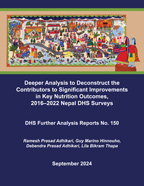There is no printed copy available to order.
Abstract:
Despite the remarkable improvements in some key child and maternal nutrition outcomes at the national
level, large disparities by region, residence, and other background characteristics remain. For example, the
prevalence of stunting among children in the poorest households is nearly triple that of those in the
wealthiest households (36.9% versus 13.1%), and the prevalence in Karnali province is double that in
Bagmati province (35.8% versus 17.6%). Further, improvements have not occurred evenly across regions
of the country. Koshi, Karnali, and Sudurpaschim provinces all saw large declines in child stunting,
underweight, and wasting between 2016 and 202,2 whereas Bagmati and Gandaki provinces experienced
more modest declines or even slight increases in some indicators. Lumbini province presents an even
greater puzzle, as the prevalence of child wasting (low weight for height) more than doubled from 7.6% in
2016 to 16.2% in 2022, without any corresponding increases in the prevalences of other indicators such as
child stunting, underweight, or anemia that often co-exist with wasting since they have common
contributors. In fact, all these indicators except wasting improved from 2016 to 2022 in Lumbini province.
The steep increase in child wasting in Lumbini province contributed substantially to the weak progress in
child wasting, nationally.
We used descriptive analysis to examine trends in socioeconomic, child-intrinsic and nutritional, maternal,
health, and environment factors and in any and severe levels of each of the nutrition outcomes from 2016
to 2022, nationally and by province.
 Deeper Analysis to Deconstruct the Contributors to Significant Improvement in Key Nutrition Outcomes, 2016-2022 Nepal DHS Surveys (PDF, 7609K)
Deeper Analysis to Deconstruct the Contributors to Significant Improvement in Key Nutrition Outcomes, 2016-2022 Nepal DHS Surveys (PDF, 7609K)
